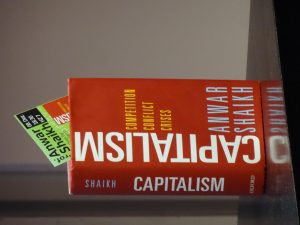Modern Monetary Theory and Disguised Unemployment
✑ NICK JOHNSON ` ╱ ± 6 minutes

Employing some ideas from Modern Monetary Theory, US Democratic politicians want to fund programmes such as universal healthcare and a ‘Green New Deal’ by increased government borrowing. Their hearts are in the right place but, as others have shown, they should not be free of critique.

Macro and micro should be analysed together.
Employing some ideas from Modern Monetary Theory, US Democratic politicians want to fund programmes such as universal healthcare and a ‘Green New Deal’ by increased government borrowing. Their hearts are in the right place but, as others have shown, they should not be free of critique.
From: The Political Economy of Development April 23, 2019 ╱ About the author
Nick Johnson has an MSc in development economics from SOAS, University of London, works for a charity, is passionately interested in economics and how it can be used to promote sustainable human progress. His personal blog: The Political Economy of Development. On twitter@nickj_econ.
Thomas Palley, a post-Keynesian economist, here provides a critique of recent policy proposals by US Democratic politicians employing some ideas from Modern Monetary Theory. They variously want to fund programmes such as universal healthcare and a ‘Green New Deal’, financed to a large degree by increased government borrowing.
MMT, as a set of ideas, is an offshoot of post-Keynesianism, but is perhaps more straightforward to grasp when it comes to budget deficits and its opposition to austerity; hence its current popular appeal.
Post-Keynesians are generally ideologically to the left of mainstream Keynesians, more concerned with ‘realistic’ assumptions when it comes to constructing economic theory and applying that to policy. They fall into the heterodox economics camp, and Palley is no exception. But he is critical of MMT.
US unemployment is currently at the historically low rate of 3.9%, so that a major fiscal boost to demand on top of the already moderate deficit would be unsustainable.
Such a low rate of unemployment suggests that the economy is not far from full capacity. However the labour force participation rate is still relatively low and, while it has been rising in recent years, it points to the fact that plenty of people have been discouraged from seeking work and have dropped out of the labour market altogether. If the economy continues to expand and create job opportunities, more of these individuals are likely to return to the labour market and the participation rate could continue to rise.
So the narrow unemployment rate is not always the best measure of labour market slack. One should always look at a range of indicators.
There may be mismatches between the skills required in newly created job openings and those possessed by individuals who are trying to rejoin the labour market after having previously dropped out. On the other hand, if firms are desperate enough to fill their vacancies, they may be more willing to provide the required training. Although this is an extra cost, it would be worth it if the firm can cover it while selling the extra output generated by a larger workforce and maintaining or increasing profitability.
Another more subtle indication of labour market slack can be the fact that the new jobs created in a weak economy are either relatively unproductive or part-time, and at low wages. In such cases, those hired might prefer to be paid more in a more productive position or one with longer hours. These kind of situations indicate the presence of what the Cambridge economist Joan Robinson called disguised unemployment.
Disguised unemployment is more likely to occur when unemployment benefits are low relative to average wages, or of a short duration. If this is the case, and when the growth of effective demand in the economy is low or negative, such as during or in the aftermath of a recession, the unemployed have little alternative but to accept jobs at lower wages or with fewer hours than they would like. They do not show up as unemployed in the basic statistics, but they are involuntarily underemployed or disguised unemployed.
If an economy with disguised unemployment starts to grow faster and effective demand strengthens, then such workers may be reallocated to higher productivity, higher wage jobs, or from part-time to full-time roles. The official rate of unemployment need not decline in this process, but average productivity and wages can rise as the economy expands and disguised unemployment falls.
There may therefore still be slack in the US labour market in the form of low participation or disguised unemployment, but Palley argues that the scale of additional government borrowing that has been proposed by some politicians would be excessive and lead to higher inflation, at least in the absence of much faster productivity growth. A more gradual approach to increasing government spending and investment and funded more from higher taxation would be more sustainable.
All this does however make the broadly Keynesian assumption that the major constraint on the expansion of demand and the potential to generate inflation lies in the labour market, so that reducing unemployment has a simple policy solution: expand aggregate demand.
On the other hand, some of those influenced more by Marxist ideas place the emphasis on the average rate of profit across the economy. Anwar Shaikh, in his magnum opus, Capitalism, argues that the profit rate is the key variable which regulates both aggregate supply and demand.
Another critique of Keynesian and post-Keynesian ideas is that they over-emphasise macroeconomics and neglect microeconomic processes such as industrial restructuring as output expands and contracts over the economic cycle. Governments often intervene in labour and product markets, not always effectively, to promote such change. This can act to restore opportunities for profit-making and investment in new capacity after a downturn or period of stagnation and declining profitability. Such arguments are also absent from MMT thinking.
Having said all that, a major programme of government investment, in green infrastructure and supporting clean technologies would create the opportunities for the private sector and could therefore raise expected profitability and investment in the private sector. This would create new employment opportunities and could reduce unemployment and underemployment. So macro and micro should be analysed together.
The progressive ideas mooted by some US politicians show that their hearts are in the right place but, as others have shown, they should not be free of critique, from heterodox quarters or elsewhere.
MMT, as a set of ideas, is an offshoot of post-Keynesianism, but is perhaps more straightforward to grasp when it comes to budget deficits and its opposition to austerity; hence its current popular appeal.
Post-Keynesians are generally ideologically to the left of mainstream Keynesians, more concerned with ‘realistic’ assumptions when it comes to constructing economic theory and applying that to policy. They fall into the heterodox economics camp, and Palley is no exception. But he is critical of MMT.
The proposed increase in the government deficit would, if carried out with the US economy in its current state, be highly inflationary.The ‘uncomfortable arithmetic’ which he describes in the brief paper linked to above demonstrates that the proposed increase in the government deficit would, if carried out with the US economy in its current state, be highly inflationary.
US unemployment is currently at the historically low rate of 3.9%, so that a major fiscal boost to demand on top of the already moderate deficit would be unsustainable.
Such a low rate of unemployment suggests that the economy is not far from full capacity. However the labour force participation rate is still relatively low and, while it has been rising in recent years, it points to the fact that plenty of people have been discouraged from seeking work and have dropped out of the labour market altogether. If the economy continues to expand and create job opportunities, more of these individuals are likely to return to the labour market and the participation rate could continue to rise.
So the narrow unemployment rate is not always the best measure of labour market slack. One should always look at a range of indicators.
There may be mismatches between the skills required in newly created job openings and those possessed by individuals who are trying to rejoin the labour market after having previously dropped out. On the other hand, if firms are desperate enough to fill their vacancies, they may be more willing to provide the required training. Although this is an extra cost, it would be worth it if the firm can cover it while selling the extra output generated by a larger workforce and maintaining or increasing profitability.
Another more subtle indication of labour market slack can be the fact that the new jobs created in a weak economy are either relatively unproductive or part-time, and at low wages. In such cases, those hired might prefer to be paid more in a more productive position or one with longer hours. These kind of situations indicate the presence of what the Cambridge economist Joan Robinson called disguised unemployment.
Disguised unemployment is more likely to occur when unemployment benefits are low relative to average wages, or of a short duration. If this is the case, and when the growth of effective demand in the economy is low or negative, such as during or in the aftermath of a recession, the unemployed have little alternative but to accept jobs at lower wages or with fewer hours than they would like. They do not show up as unemployed in the basic statistics, but they are involuntarily underemployed or disguised unemployed.
If an economy with disguised unemployment starts to grow faster and effective demand strengthens, then such workers may be reallocated to higher productivity, higher wage jobs, or from part-time to full-time roles. The official rate of unemployment need not decline in this process, but average productivity and wages can rise as the economy expands and disguised unemployment falls.
There may therefore still be slack in the US labour market in the form of low participation or disguised unemployment, but Palley argues that the scale of additional government borrowing that has been proposed by some politicians would be excessive and lead to higher inflation, at least in the absence of much faster productivity growth. A more gradual approach to increasing government spending and investment and funded more from higher taxation would be more sustainable.
All this does however make the broadly Keynesian assumption that the major constraint on the expansion of demand and the potential to generate inflation lies in the labour market, so that reducing unemployment has a simple policy solution: expand aggregate demand.
On the other hand, some of those influenced more by Marxist ideas place the emphasis on the average rate of profit across the economy. Anwar Shaikh, in his magnum opus, Capitalism, argues that the profit rate is the key variable which regulates both aggregate supply and demand.
Some of those influenced more by Marxist ideas place the emphasis on the average rate of profit across the economy.For Shaikh, a declining average rate of profit, all else equal, will tend to lead to weaker investment and economic growth. Should the government then increase the fiscal deficit to boost demand, this can raise output in the short run, but if the profit rate fails to rise in response, the result can be higher inflation alongside weaker growth in the longer run. This provides an explanation for stagflation (rising inflation with rising unemployment), such as occurred in many rich countries during the 1970s and which ultimately led to the abandonment of the Keynesian social-democratic consensus.
Another critique of Keynesian and post-Keynesian ideas is that they over-emphasise macroeconomics and neglect microeconomic processes such as industrial restructuring as output expands and contracts over the economic cycle. Governments often intervene in labour and product markets, not always effectively, to promote such change. This can act to restore opportunities for profit-making and investment in new capacity after a downturn or period of stagnation and declining profitability. Such arguments are also absent from MMT thinking.
Having said all that, a major programme of government investment, in green infrastructure and supporting clean technologies would create the opportunities for the private sector and could therefore raise expected profitability and investment in the private sector. This would create new employment opportunities and could reduce unemployment and underemployment. So macro and micro should be analysed together.
The progressive ideas mooted by some US politicians show that their hearts are in the right place but, as others have shown, they should not be free of critique, from heterodox quarters or elsewhere.
| Top image: Representative Alexandria Ocasio-Cortez (center) speaks on the Green New Deal with Senator Ed Markey (right) in front of the Capitol Building in February 2019. From: Wikimedia |
|---|























Comments
Post a Comment
Your thoughts...